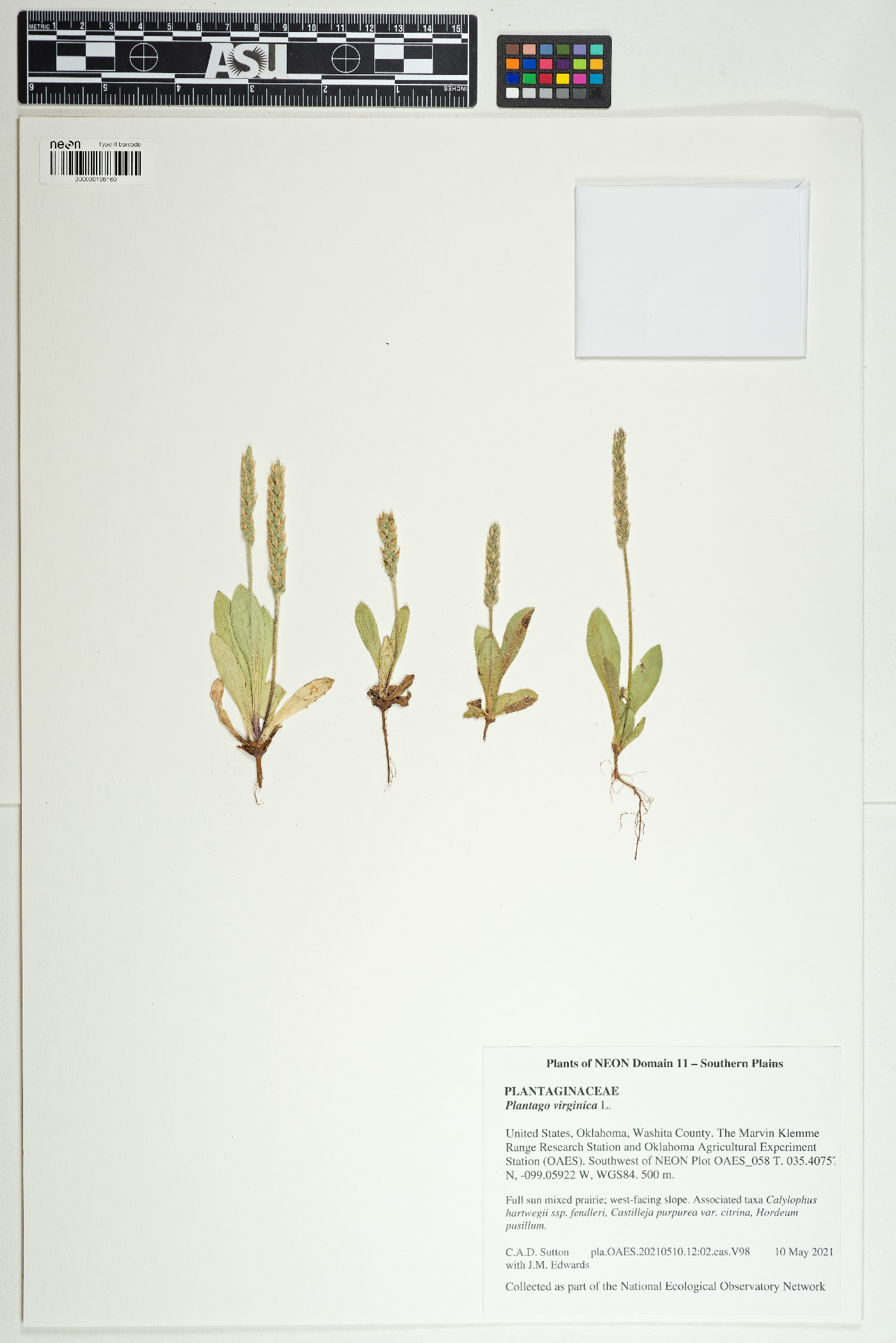Search
View the original page version
Plantago virginica
|
|
|
|
Family: Plantaginaceae
Virginia plantain
[Plantago virginica var. viridescens Fernald] |
Plant: Annual herb; to 34.5 cm tall Leaves: petiolate; blades lanceolate, 2.5-10 cm long, 0.8-2.7 cm wide, attenuate at base, acute at apex, sparsely villous, distincly 3-veined, sometimes with 2-4 widely-spaced teeth INFLORESCENCE: pedunculate, scapose; PEDUNCLES 1-20 cm long. SPIKES 1.5-17 cm long, sparsely to densely villous; bracts subulate to narrowly or broadly triangular, 2-4.8 mm long, narrowly scarious-margined at base, ciliate Flowers: more or less dioecious; sepals ovate, 2.5-3 mm long, broadly scarious-margined, acuminate at apex, obtuse to subacute at base, hirsute only on midrib; corolla lobes erect, enclosing the capsule (sometimes spreading in staminate flowers), lanceolate, 2-3 mm long; stamens 4 Fruit: capsules, breaking at middle; SEEDS 2, ellipsoid, 0.9-3.0 mm long, 0.8-1.6 mm wide, light brown, the inner surface deeply concave, the outer surface furrowed Misc: Disturbed areas; 450-1300 m (1500-4200 ft.); Mar-Jul REFERENCES: Huisinga, Kristin D. and Tina J. Ayers. 1999. Plantaginaceae. Ariz. - Nev. Acad. Sci. 32(1). Annual of biennial herb with a taproot flowering stem to 20 cm tall Leaves: basal, 5 - 10 cm long, reverse lance-shaped to reverse egg-shaped with a blunt apex, more or less parallel-veined, sometimes inconspicuously toothed, and hairy. Inflorescence: a dense spike of many flowers, arising from a leafless stalk (scape), 3 - 10 cm long, 6 - 8 mm wide, moderately woolly. Flowers: stalkless or nearly stalkless, subtended by lance-shaped bracts, not fragrant. Bracts minutely hairy. Stamens four, exserted, alternate with corolla lobes. Style one. Sepals: four, green, 2 - 2.5 mm long, oblong reverse egg-shaped with a rounded apex, scarious-margined (dry, thin, and membranous), with a minutely hairy keel. Fruit: a dehiscent capsule (circumscissile). Seeds two, pale brown, 1.3 - 2 mm long, less than half as wide, convex on one side, concave on the other. Corolla: four-lobed, whitish, scarious (dry, thin, membranous). Lobes upright, 1 - 3 mm long. The corollas of fertile flowers close over the maturing capsule. Similar species: Plantago media is similar but its corollas do not close over the maturing capsules and the flowers are fragrant. Flowering: May to early June Habitat and ecology: Infrequent in the Chicago Region. Found in fallow fields and pastures. Often found in acid sandy soil. Occurence in the Chicago region: native Etymology: Plantago comes from the Latin word planta, meaning footprint. Virginica means "of or from Virginia." Author: The Morton Arboretum Taprooted, hirsutulous annual or biennial; lvs oblanceolate to obovate, 5-10(-15) cm, obtuse, entire or inconspicuously toothed; scape to 2 dm; spikes 3-10(-20) cm נ6-8 mm; bracts lanceolate, mostly shorter than the cal, hirsutulous, a scarious margin scarcely developed; sep oblong-obovate, rounded above, the keel hirsutulous, the scarious margin broad and glabrous; cor-lobes 1-3 mm, erect and connivent even in fr; seeds 2, 1.3-2 mm, less than half as wide, convex on the back, strongly concave on the inner face, the hilum nearly as long as the seed; 2n=24. Occasional plants have chasmogamous fls with spreading cor-lobes. A spring ephemeral of dry or sandy soil, often weedy; Mass. and N.Y. to Wis., Io., and S.D., s. to Fla. and Tex., and intr. westward. Gleason, Henry A. & Cronquist, Arthur J. 1991. Manual of vascular plants of northeastern United States and adjacent Canada. lxxv + 910 pp. ©The New York Botanical Garden. All rights reserved. Used by permission. Huisinga and Ayers 1999, Kearney and Peebles 1969 Duration: Annual Nativity: Native Lifeform: Forb/Herb General: Annual herb to 34.5 cm tall. Leaves: Petiolate, blades lanceolate 2.5-10 cm long, .8-2.7 cm wide, attenuate at base, acute at apex, sparsely villous, distinctly 3-veined, sometimes 2-4 widely-spaced teeth. Flowers: Peduncles 1-20 cm long, spikes 1.5-17 cm long, sparsely to densely villous, subulate bracts narrowly or broadly triangular, 2-4.8 mm long, narrowly scarious-margined at base, ciliate; more or less dioecious flowers, ovate sepals 2.5-3 mm long, 4 stamens. Fruits: Capsule breaks at middle. Ecology: Found in disturbed areas from 1,500-4,500 ft (457-1372 m); flowers March-July. Distribution: Most states in the U.S. except the northwest; south to s MEX.; also in Asia and Africa. Notes: This species distinguished by leaves lanceolate, >1 cm wide, acute at the apex and with 2-3 remote, shallow teeth; and corolla lobes strictly erect at maturity, enclosing the capsule. Similar to P. rhodosperma, but otherwise clearly distinguishable. Ethnobotany: Used ceremonially. Etymology: Plantago translates to foot-sole in reference to leaf habit on ground, while virginica means Virginia. Synonyms: Plantago virginica var. viridescens Editor: SBuckley 2010, FSCoburn 2015 |

